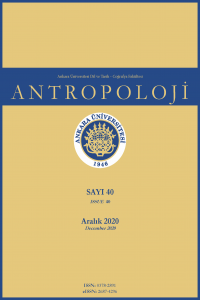Abstract
This paper is a contact area about the sets of meaning which we call belonging, which turns itself on the axis of differing descriptions in every field of daily life. It is an effort to put writing individuals’ perspectives of readiness for sacrifice for safe zones specific to those sets of belonging. In other words, their perspectives of how they marginalize the unsafe zones. Efforts are made in this study to make sense of the methods of discovering how the areas, which are referred to as borders of community, are protected by using the data provided by visual anthropology. Having contact with those mysterious borders, which are sacred, meets great resistance. The data provided by visual anthropology in relation to the resistance minimise the contact. The research object of this study is the documentary “Hala” (Aunt) directed by Veysel Akşahin. It was chosen as the object of study due to the fact that it was away from fictionality. The documentary which was considered specifically as “Aunt Ihsan”, was divided into parts and analyzed thus, and then efforts were made to describe how the label “Aunt”, the image which develop performatively through İhsan Çolak, was assigned meaning.
References
- Akşahin, V. (Yönetmen) (2012). Hala [Belgesel]. Erciyes Üniversitesi.
- Barutçu, A. (2013). Türkiye’de erkeklik inşasının bedensel ve toplumsal aşamaları. Yayımlanmamış yüksek lisans tezi. Ankara Üniversitesi Sosyal Bilimler Enstitüsü, Ankara.
- Bauman, Z. (2017). Cemaatler, 2. basım. (N. Soysal, çev.). Say Yayınları.
- Ceylan, T. (2011). Toplumsal sistem analizinde toplumsal statü ve rol, Atatürk Üniversitesi Sosyal Bilimler Enstitüsü Dergisi, 15(1), 89-104.
- Douglas, M. (2016). Kurumlar nasıl düşünür? (İ. Çoşkun, çev.). İthaki Yayınları.
- Durkheim, E. (2010). Dinsel yaşamın ilk biçimleri. (Ö. Ozankaya, çev.). Cem Yayınevi.
- Durkheim, E. (2015). Sosyolojik yöntemin kuralları, 3. basım. (C. B. Akal, çev.). Dost Yayınları.
- Eroğlu, H. Ö. (2016). Foucault’un iktidarları. Amme İdaresi Dergisi, 49(2), 39-54.
- Goffman, E. (2014). Damga. Örselenmiş kimliğin idare edilişi üzerine notlar, 2. basım. (Ş. Geniş, L. Ünsaldı ve S. N. Ağırnaslı, çev.). Heretik Yayıncılık.
- Goffman, E. (2020). Günlük yaşamda benliğin sunumu, 3. basım. (B. Cezar, çev.). Metis Yayınları.
- Karacagil, Z. (2017). Erkekliğin kurgulanmasında askerlik hizmeti. International Journal of Human Sciences, 14(4), 4410-4424. https://doi.org/10.14687/jhs.v14i4.4913
- Sarup, M. (2004). Post-yapısalcılık ve postmodernizm, 2. basım. (A. Güçlü, çev.). Bilim ve Sanat Yayınevi.
- Tönnies, F. (2019). Cemaat ve cemiyet. (E. Güler, çev.). Vakıfbank Kültür Yayınları.
Abstract
References
- Akşahin, V. (Yönetmen) (2012). Hala [Belgesel]. Erciyes Üniversitesi.
- Barutçu, A. (2013). Türkiye’de erkeklik inşasının bedensel ve toplumsal aşamaları. Yayımlanmamış yüksek lisans tezi. Ankara Üniversitesi Sosyal Bilimler Enstitüsü, Ankara.
- Bauman, Z. (2017). Cemaatler, 2. basım. (N. Soysal, çev.). Say Yayınları.
- Ceylan, T. (2011). Toplumsal sistem analizinde toplumsal statü ve rol, Atatürk Üniversitesi Sosyal Bilimler Enstitüsü Dergisi, 15(1), 89-104.
- Douglas, M. (2016). Kurumlar nasıl düşünür? (İ. Çoşkun, çev.). İthaki Yayınları.
- Durkheim, E. (2010). Dinsel yaşamın ilk biçimleri. (Ö. Ozankaya, çev.). Cem Yayınevi.
- Durkheim, E. (2015). Sosyolojik yöntemin kuralları, 3. basım. (C. B. Akal, çev.). Dost Yayınları.
- Eroğlu, H. Ö. (2016). Foucault’un iktidarları. Amme İdaresi Dergisi, 49(2), 39-54.
- Goffman, E. (2014). Damga. Örselenmiş kimliğin idare edilişi üzerine notlar, 2. basım. (Ş. Geniş, L. Ünsaldı ve S. N. Ağırnaslı, çev.). Heretik Yayıncılık.
- Goffman, E. (2020). Günlük yaşamda benliğin sunumu, 3. basım. (B. Cezar, çev.). Metis Yayınları.
- Karacagil, Z. (2017). Erkekliğin kurgulanmasında askerlik hizmeti. International Journal of Human Sciences, 14(4), 4410-4424. https://doi.org/10.14687/jhs.v14i4.4913
- Sarup, M. (2004). Post-yapısalcılık ve postmodernizm, 2. basım. (A. Güçlü, çev.). Bilim ve Sanat Yayınevi.
- Tönnies, F. (2019). Cemaat ve cemiyet. (E. Güler, çev.). Vakıfbank Kültür Yayınları.
Details
| Primary Language | Turkish |
|---|---|
| Subjects | Anthropology |
| Journal Section | Research Articles |
| Authors | |
| Publication Date | December 30, 2020 |
| Submission Date | October 30, 2020 |
| Acceptance Date | November 15, 2020 |
| Published in Issue | Year 2020 Issue: 40 |

All the published contents in Antropoloji are licensed under Creative Commons Attribution-NonCommercial 4.0 International License (CC BY-NC 4.0). That means the published contents can be used elsewhere by giving appropriate credits, references and a link to the license. Users should also indicate if any changes to the original work have been made. Moreover, users cannot use the original and/or derived material for any commercial purposes. Briefly, the author(s) and reader(s) can reproduce and/or spread the published and/or electronic content in Antropoloji, without any commercial purposes. Nevertheless, this does not necessarily mean that Antropoloji will endorse you or your work as the licensor.
Budapest Open Access Initiative


